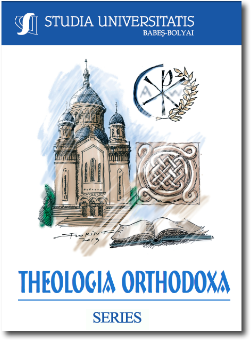FROM ‘VEIL’ (καταπέτασμα) THEOLOGY TO ‘FACE’ (πρόσωπον) CHRISTOLOGY. BODY AS A VEIL CONCEALING DIVINE GLORY - DIRECT EXPERIENCE AND IMMEDIATE PERCEPTION (αἴσθησις) OF GOD
FROM ‘VEIL’ (καταπέτασμα) THEOLOGY TO ‘FACE’ (πρόσωπον) CHRISTOLOGY. BODY AS A VEIL CONCEALING DIVINE GLORY - DIRECT EXPERIENCE AND IMMEDIATE PERCEPTION (αἴσθησις) OF GOD
Author(s): Nichifor TănaseSubject(s): Theology and Religion
Published by: Studia Universitatis Babes-Bolyai
Keywords: Veil (καταπέτασμα); Ephraem the Syrian; robe of glory; Divine Names; Dionysius the Areopagite; Pneumatic bodies; “clothed with Christ”; divine ‘Face’; ‘Light’ theophany; Gregory Palamas.
Summary/Abstract: According to Pauline theology we are ‘earthen vessels’ (2 Cor. 4:7) till Christ is formed in us (Gal. 4:19). Into the most holy place of our being, in which the very presence of God dwells, He ‘enters within the veil’ (Heb. 6:19) and ‘put in our hearts the light’ (2 Cor. 4:6). So, being ‘clothed in Christ’ (Gal. 3:27) we all are being ‘transformed into his image’ which is the ‘form of God’ ἐν μορφῇ Θεοῦ (Phil. 2:6). To Saint Ephrem, “The First-born wrapped himself in a body / as a veil to hide His glory” (CNis XLIII,21, LumE 74). He juxtaposes the image of Moses being veiled with Jesus’ veiling on Himself in the Incarnation. Face of Moses shone and he laid veil over his face, just as Lord, from the Womb, entered and put on the veil of the Body (Nativity 73). Also, the veil of the temple was intended by Moses to symbolize the veil of heaven, and both veils together prefigured the flesh of Christ, which enfolded and concealed his divinity. Firstly, we will focus on the analogy between Thabor’s garments and bodies in the water of Baptism (De Epiphania 9, 12), both glory / Light garments of the Son, the “Father Ray” (Heb. 1: 3; Sogyatha I 1-2). Secondly, we are interested in St. Ephrem’s interpretation of Matthew 27:50-51 (The Crucifixion IV, 1-12, Comm. Diatess. XXI, 4-6). Here, he combines two Pauline texts (Heb. 6:19 and 2 Cor. 3: 14-18) showing that, in fact, the veil split gave back to the Lord the glory that Jews have rejected. The latters dressed him with veil altar (Azym. V, 6 – the purple, which was the inner veil of the temple; Katapetesma: a curtain) actually they clothed Him with His symbol of the divine glory presence. The Veil of Light is that who hides the apophatic ‘aesthetics’ of God’s Face. This is the way of concealing the divinity from velum scissum to the eucharistic bread. In this view the Body becomes the ‘Veil of flesh’ (καταπέτασμα) in accordance with the clothing imagery. This study is about the Biblical, syrian and hesychast perichoretic interweaving of visible (created) and invisible (uncreated). First, the syntagm “Within the Veil” (καταπέτασμα) is related to the biblical and patristic understanding of salvation as a garment. Thus, the Syrian (nuhrā qaddīša Ephrem’s “eṣtal šubḥa”) is nothing less than the reception of Paul (veil of flesh, Heb 10:20) spirituality of divine light (δόξα). Dionysius speaks of his spiritual father, Hierotheos who is “suffering” the mystery of the Incarnation (παθὼν τὰ θεῖαν, DN II, 9). So, holy man is “theophanic”, becoming present to the Trinity (DN III, 1) and the hierarchy’s members becomes “spotless mirrors of the primordial light” (icons of the divine energies). Theurgic light and deiformity (θεοειδεῖ) by union with the rays of the unapproachable light. “Suddenly” (ἐξαίφνης) vision of Christ in light represents the divine motion as God extended “ecs[aes]tetically” into immanence. Therefore, the theophany of light (ἀπρόσιτον ϕῶς) is Imparticipable participable (τὰ ἀμεθέκτως μετεχόμενα) and God ad extra.Accordingly, the veil (καταπέτασμα) theology is the hermeneutical key to reveal by concealing the divine presence, a real point of contact or somatic experience. In a word, God’s self-revelation as concealing presence. Perichoresis of the visible and the invisible (interweaving of the created and the uncreated in biblical, syrian and hesychast clotihing metaphors) becomes possible within the body, understood as a ‘veil’. The biblical theology of clothing, especially the Significance of Clothing Imagery in the Pauline and the Clothing Metaphors, as a Means of Theological Expression in Syriac Tradition are both engaged to understand the late hesychast theology of uncreated light, this vision of God being “veiled unveiling” or hidden in his manifestation. The flesh becomes the veil of (καταπέτασμα) God’s self-revelation (a concealing presence) and the “shining face” of both the Desert Fathers, as well as the byzantine hesychasts, during prayer, is the witness of the realism of that communion, being the point of tangency of created (aesthetics) body and uncreated (apophatic) light.
Journal: Studia Universitatis Babes-Bolyai - Theologia Orthodoxa
- Issue Year: LXII/2017
- Issue No: 2
- Page Range: 119-181
- Page Count: 64
- Language: English

